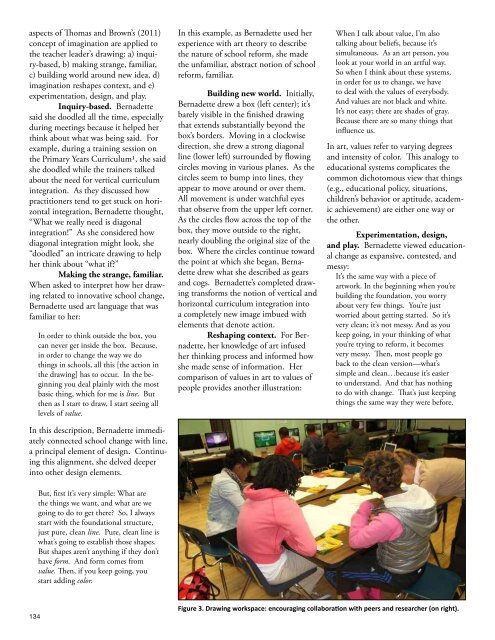Torrance Journal for Applied Creativity
TorranceJournal_V1
TorranceJournal_V1
You also want an ePaper? Increase the reach of your titles
YUMPU automatically turns print PDFs into web optimized ePapers that Google loves.
aspects of Thomas and Brown’s (2011)<br />
concept of imagination are applied to<br />
the teacher leader’s drawing: a) inquiry-based,<br />
b) making strange, familiar,<br />
c) building world around new idea, d)<br />
imagination reshapes context, and e)<br />
experimentation, design, and play.<br />
Inquiry-based. Bernadette<br />
said she doodled all the time, especially<br />
during meetings because it helped her<br />
think about what was being said. For<br />
example, during a training session on<br />
the Primary Years Curriculum1, she said<br />
she doodled while the trainers talked<br />
about the need <strong>for</strong> vertical curriculum<br />
integration. As they discussed how<br />
practitioners tend to get stuck on horizontal<br />
integration, Bernadette thought,<br />
“What we really need is diagonal<br />
integration!” As she considered how<br />
diagonal integration might look, she<br />
“doodled” an intricate drawing to help<br />
her think about “what if?”<br />
Making the strange, familiar.<br />
When asked to interpret how her drawing<br />
related to innovative school change,<br />
Bernadette used art language that was<br />
familiar to her:<br />
In order to think outside the box, you<br />
can never get inside the box. Because,<br />
in order to change the way we do<br />
things in schools, all this [the action in<br />
the drawing] has to occur. In the beginning<br />
you deal plainly with the most<br />
basic thing, which <strong>for</strong> me is line. But<br />
then as I start to draw, I start seeing all<br />
levels of value.<br />
In this description, Bernadette immediately<br />
connected school change with line,<br />
a principal element of design. Continuing<br />
this alignment, she delved deeper<br />
into other design elements.<br />
But, first it’s very simple: What are<br />
the things we want, and what are we<br />
going to do to get there? So, I always<br />
start with the foundational structure,<br />
just pure, clean line. Pure, clean line is<br />
what’s going to establish those shapes.<br />
But shapes aren’t anything if they don’t<br />
have <strong>for</strong>m. And <strong>for</strong>m comes from<br />
value. Then, if you keep going, you<br />
start adding color.<br />
In this example, as Bernadette used her<br />
experience with art theory to describe<br />
the nature of school re<strong>for</strong>m, she made<br />
the unfamiliar, abstract notion of school<br />
re<strong>for</strong>m, familiar.<br />
Building new world. Initially,<br />
Bernadette drew a box (left center); it’s<br />
barely visible in the finished drawing<br />
that extends substantially beyond the<br />
box’s borders. Moving in a clockwise<br />
direction, she drew a strong diagonal<br />
line (lower left) surrounded by flowing<br />
circles moving in various planes. As the<br />
circles seem to bump into lines, they<br />
appear to move around or over them.<br />
All movement is under watchful eyes<br />
that observe from the upper left corner.<br />
As the circles flow across the top of the<br />
box, they move outside to the right,<br />
nearly doubling the original size of the<br />
box. Where the circles continue toward<br />
the point at which she began, Bernadette<br />
drew what she described as gears<br />
and cogs. Bernadette’s completed drawing<br />
trans<strong>for</strong>ms the notion of vertical and<br />
horizontal curriculum integration into<br />
a completely new image imbued with<br />
elements that denote action.<br />
Reshaping context. For Bernadette,<br />
her knowledge of art infused<br />
her thinking process and in<strong>for</strong>med how<br />
she made sense of in<strong>for</strong>mation. Her<br />
comparison of values in art to values of<br />
people provides another illustration:<br />
When I talk about value, I’m also<br />
talking about beliefs, because it’s<br />
simultaneous. As an art person, you<br />
look at your world in an artful way.<br />
So when I think about these systems,<br />
in order <strong>for</strong> us to change, we have<br />
to deal with the values of everybody.<br />
And values are not black and white.<br />
It’s not easy; there are shades of gray.<br />
Because there are so many things that<br />
influence us.<br />
In art, values refer to varying degrees<br />
and intensity of color. This analogy to<br />
educational systems complicates the<br />
common dichotomous view that things<br />
(e.g., educational policy, situations,<br />
children’s behavior or aptitude, academic<br />
achievement) are either one way or<br />
the other.<br />
Experimentation, design,<br />
and play. Bernadette viewed educational<br />
change as expansive, contested, and<br />
messy:<br />
It’s the same way with a piece of<br />
artwork. In the beginning when you’re<br />
building the foundation, you worry<br />
about very few things. You’re just<br />
worried about getting started. So it’s<br />
very clean; it’s not messy. And as you<br />
keep going, in your thinking of what<br />
you’re trying to re<strong>for</strong>m, it becomes<br />
very messy. Then, most people go<br />
back to the clean version—what’s<br />
simple and clean…because it’s easier<br />
to understand. And that has nothing<br />
to do with change. That’s just keeping<br />
things the same way they were be<strong>for</strong>e.<br />
134<br />
Figure 3. Drawing workspace: encouraging collaboration with peers and researcher (on right).


